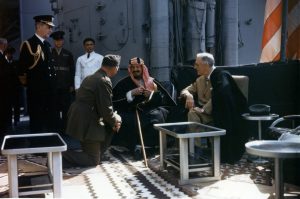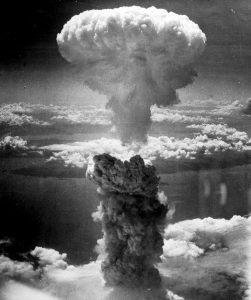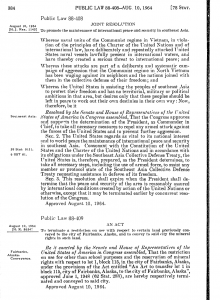President Roosevelt with King Ibn Saud, unknown photographer (1945)

This photograph was taken by an unknown American serviceman aboard the USS Quincy on February 14, 1945, and pictures President Roosevelt meeting with King Ibn Saud of Saudi Arabia shortly after the Yalta Conference. The meeting covered several political developments in the Middle East, such as the plan to move European Jews to Palestine (which was vehemently opposed by the Saudi King). However, the main goal of the meeting from Roosevelt’s perspective was to further cement the American stake in Arabian oil fields, which was accomplished by promising American support and military training for Saudi Arabia. This source is significant because it shows that in US foreign policy, economic interests vastly overshadowed American values (demonstrated by FDR’s support for an anti-Semitic absolute monarch).
“Atomic Cloud Rises Over Nagasaki, Japan”, photographed by Charles Levy (1945)

In this photograph, captured by Charles Levy from a B-29 Superfortress overhead, a massive mushroom cloud can be seen forming over 60,000 feet in the air after the atomic bomb was dropped on Nagasaki. This marked the first and only time an atomic weapon was utilized in war against an enemy, and truly solidified American hegemonic power. At the cost of the annihilation of hundreds of thousands of Japanese civilians, the United States secured victory for the allies in the Pacific theater. While many government officials have argued that the bombing was necessary to end the war in order to avoid a land invasion of Japan, there is speculation that the true purpose was a “showing of power” aimed at the Soviet Union. Nonetheless, the bombing still demonstrates a complete disregard for the lives of an incredible amount of innocent civilians.
“Tonkin Gulf Resolution”, Congressional bill (1964)

This source is the official Congressional bill put in place after the Gulf of Tonkin Resolution was passed several days prior. The bill was in response to several naval confrontations between the US and North Vietnamese ships several weeks prior, and authorized President Johnson to “take all necessary measures to repel any armed attack and prevent further aggression”, effectively allowing for America’s entrance into the war without an official declaration by Congress (which is typically constitutionally required). However, it is now known that at least one of the incidents was completely fabricated by the US government in order to justify its entrance into the conflict.
